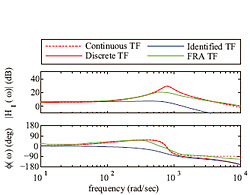High Performance Dc-Dc Converters
Grant Pitel with adviser P. T. Krein

Figure 30: The identified TF compared to parameter, continuous TF, and discrete TF and measured using frequency response analysis (FRA).
High-performance power electronics in the microelectronics industry must deliver clean voltage in the presence of fast load steps, maintain low cost, and achieve high efficiency. Because of limits in IC fabrication, processors run at low voltages and use multiple cores and on-board power management in order to improve instructions per Watt. This research explores the fundamental performance limits in power processing and proposes digital control and topology strategies to overcome these challenges.
The best dc-dc converter performance occurs when the controller has complete knowledge of its components and the load—the latter being the more difficult to obtain. Real-time system identification was investigated, a process that identifies a power converter’s input-to-output transfer function (TF) from input and output samples. The identified TF was compared to parameter, continuous TF, and discrete TF and measured using frequency response analysis (FRA), as shown in Figure 30. Experimental and simulated results demonstrate that an identification algorithm could quickly identify a TF from a step-input. However, load steps did not produce enough output oscillation for the algorithm to make an accurate TF estimate.
This work is supported by National Science Foundation grant NSF ECS 06-21643.